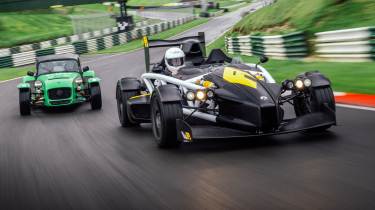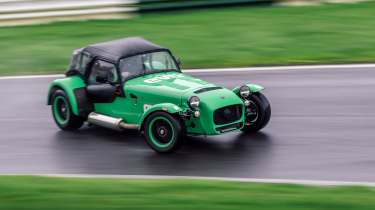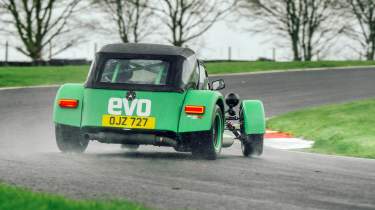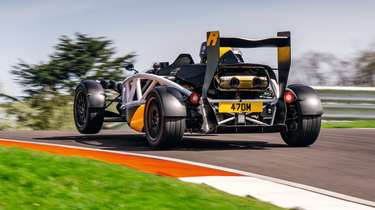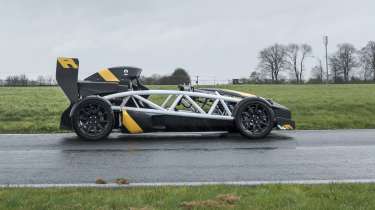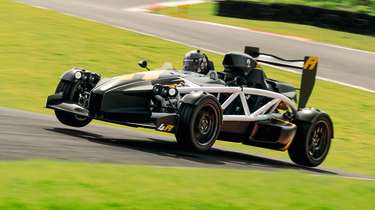Ariel Atom 4R v Caterham Seven ‘evo25’: power-to-weight heroes go head-to-head
Power-to-weight enters a new dimension with the scintillating Caterham Seven and the ferocious, turbocharged Atom 4R
Power‑to-weight ratios to shame a supercar (or hypercar!), at-best rudimentary weather protection, two seats and a single-minded focus on driving thrills. The Ariel Atom and Caterham Seven are unashamed headbangers that can be driven on the road but truly come alive on track.
The ‘evo25’ edition is our idea of the ideal road and trackday Caterham Seven. As such it’s a mash-up of the best bits from the 420S, 420R and 420 Cup. Starting with the narrow chassis and lowered floors, we added the more practical ‘Trackday’ roll-cage as opposed to the full-on race version, comfort seats, less vocal rear-exit exhaust and full weather equipment (including a heater). So far, so sensible.
> BMW M3 CS v Litchfield BMW M2: which makes the better track car?
On the wild side, we have 420 Cup mechanicals, with a dry-sump 2-litre Duratec engine developing 210bhp and 150lb ft, hooked up to a five-speed manual, plus wide-track suspension, a limited-slip diff, ten-setting adjustable Bilstein dampers and Avon ZZS tyres on lightweight 13-inch wheels. On Cadwell’s scales with 33 litres of fuel, it weighs in at 612kg, making it comfortably the lightest car in this year’s evo Track Car of the Year test.
Snugly located with arms and legs outstretched like a ’60s GP driver, you don’t so much get into a Caterham as wear it. The Duratec engine barks with familiar exuberance and responds to throttle inputs with the immediacy of a light switch. The controls are weightier than you might expect, but the physicality is matched by feel. Rare is the machine that sits you lower or further back, but nothing this side of a go-kart feels as intuitive.
That 420 Cup powertrain means vivid straight-line performance, at least up to 100mph, but the brick-like shape blunts your speed once into three figures. This means tracks such as Silverstone or Spa can leave a Seven feeling a bit swamped, but as made-in-heaven pairings go, Cadwell and a Caterham are right up there with gin and tonic or strawberries and cream.
More reviews
Group tests
Reviews
- Ariel Atom 4 2025 review – Britain's exoskeletal track toy just got torquier...
- Ariel Atom 1 (1999 - 2003) review, history and specs of the bare-bones sports car
- Ariel Atom 4R 2025 review – skeletal track special is more intense than ever
- Ariel Atom 3.5 (2013 - 2018) review, history and specs
- Ariel Atom 3 (2007 - 2013) review, history and specs
Getting the best from a Seven requires a reset, the emphasis on nailing braking points shifted to carrying as much speed as possible. The approach to Coppice is a real test because it looks like too much of a corner to be anywhere near flat-out, but is actually that very best of corners, one that’s almost flat. The way the Caterham smears its way through fast corners is hugely satisfying, largely because of the raw speed, but also because of the confidence it gives you and how it communicates its limits. There’s tons of grip, but it’s always malleable, so you can l-e-a-n into the increasing lateral load until the front, rear or, as is more likely, both ends slowly relinquish their hold.
Slower corners hold their own appeal, the Seven’s willingness to slide on the throttle tempered by its minimal mass, meaning you can kick the tail out without having to manage the momentum of a conventional car. Similarly, the way it completes lap after lap without wilting is a revelation if you’ve come from cars that overwork tyres and brakes.
Like the Seven, the Atom is in a continual state of evolution, with ever-feistier powertrains, improved handling, increasingly sophisticated hardware and exponentially spectacular performance. This 4R is a shop window for the full scope of what Ariel currently has to offer, the suite of options almost doubling the £77,940 asking price of a standard 4R to a whopping £140,000 (for reference, a standard Caterham-built 420S is £44,985).
The engine and gearbox package is top tier, the turbocharged Honda engine tuned to 400bhp and 370lb ft with a three-stage switchable map and mated to a Quaife pneumatic sequential paddleshift gearbox. The chassis is uniquely distinctive and beautifully made. And because so much of the Atom’s componentry is exposed you appreciate every last piece, from the gold-bodied pushrod-operated Öhlins dampers (with 23 clicks of adjustment) and aero-section wishbones to the carbon wheels and brakes, a combination that lightens unsprung weight by 26kg (as-tested this car weighs 725kg with fuel).
Like the GT3 RS, the Atom 4R offers bewildering scope for adjustment, including Bosch Motorsport traction control and ABS – a first on an Atom – which offers 12-stage adjustment via a rotary switch on the dash. We go with Ariel’s recommended settings for suspension, traction and ABS, plus the full 400bhp Stage 3 ‘party’ mode for the engine.
The Atom has always been unlike anything else to drive, the web-like structure and exposed front wheels somehow creating the illusion that you’re as close to the front axle as you are to the rear in the Caterham. The 4R’s turbo engine huffs and flutters, but there’s steel behind the respiratory chorus, as you’d expect from a car with more than 600bhp-per-ton.
That sense of being on the nose of the car comes from the immediacy with which the Atom changes direction. The unassisted steering is light and direct, and with heat in the tyres you get an inspiring sense of connection, something that hasn’t always been present in the Atom.
In raw accelerative terms the 4R devours straights. It has ludicrous shove in every gear, to the point where once in top you’re vainly pulling the right-hand paddle for more, like an infantryman squeezing the trigger on an empty magazine. Only the Spartan feels more explosive.
The damping has an almost luxurious plushness that filters surface distractions and controls lateral, longitudinal and vertical energy with tight precision. You sense the Atom has a narrower operating window than the Caterham, but you can still drive it on the throttle (assuming you’ve fed yourself enough slack via the Bosch TC). The brakes are feelsome and immensely powerful. With a lovely firm pedal and the reassurance of ABS you can work them harder and further into the corners. It’s a masterful fusion of analogue and digital.
For Barker the 4R is little short of a revelation: ‘I haven’t driven an Atom for some years and, bloody hell, it’s evolved significantly. They’ve long been stunningly accelerative but that has come with a sense that the front end isn’t quite as nailed down and grippy as you’d hope. Not any more. Add in carbon brakes – with anti-lock! – and your confidence shifts onto a higher plane. Staggering.’
The comparative lap times are misleading. Yes, the Atom’s 1:31.67 monsters the Seven’s 1:37.51, but interrogate the Vbox and you see the Ariel’s advantage comes between the corners rather than through them. By the end of Park Straight it’s at almost 135mph compared to a little over 118mph for the Caterham. However, look at cornering speeds and the Seven’s tenacity is clear to see, almost matching the Atom’s turn-in speed into Coppice (103mph v 104.7mph), carrying more speed into Charlie’s (97.9/97.3), and maintaining higher minimum speeds through the Gooseneck (75.3/73.1) and Hall Bends (61.3/60.7).
I’m not sure you could find two cars separated by such a chunk of time that are so closely aligned in terms of the excitement and satisfaction they deliver. A Caterham defines the track driving experience in so many ways it is effectively beyond comparison. ‘After all these years, it’s still such a great entertainer,’ says Barker. For its part, the Atom 4R boldly moves things on while remaining true to the Ariel ethos. Both are magnificent, singular experiences. Can it really get any better than this?
This story was first featured in evo issue 322.
